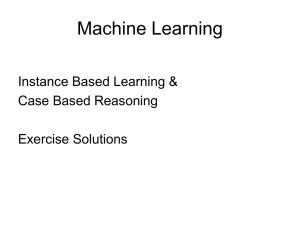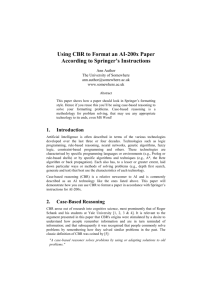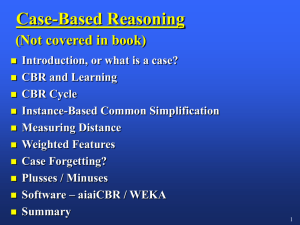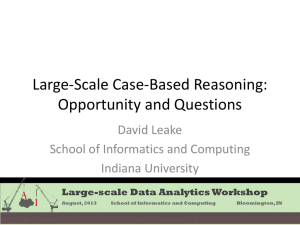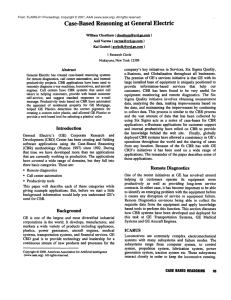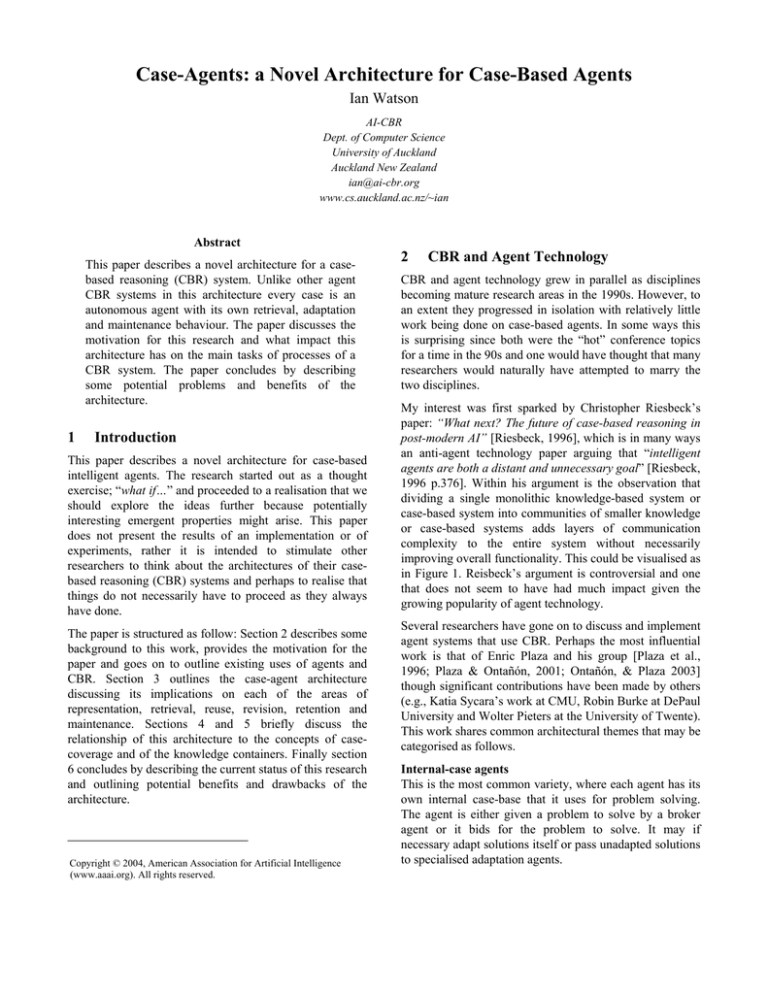
Case-Agents: a Novel Architecture for Case-Based Agents
Ian Watson
AI-CBR
Dept. of Computer Science
University of Auckland
Auckland New Zealand
ian@ai-cbr.org
www.cs.auckland.ac.nz/~ian
Abstract
This paper describes a novel architecture for a casebased reasoning (CBR) system. Unlike other agent
CBR systems in this architecture every case is an
autonomous agent with its own retrieval, adaptation
and maintenance behaviour. The paper discusses the
motivation for this research and what impact this
architecture has on the main tasks of processes of a
CBR system. The paper concludes by describing
some potential problems and benefits of the
architecture.
1
Introduction
This paper describes a novel architecture for case-based
intelligent agents. The research started out as a thought
exercise; “what if…” and proceeded to a realisation that we
should explore the ideas further because potentially
interesting emergent properties might arise. This paper
does not present the results of an implementation or of
experiments, rather it is intended to stimulate other
researchers to think about the architectures of their casebased reasoning (CBR) systems and perhaps to realise that
things do not necessarily have to proceed as they always
have done.
The paper is structured as follow: Section 2 describes some
background to this work, provides the motivation for the
paper and goes on to outline existing uses of agents and
CBR. Section 3 outlines the case-agent architecture
discussing its implications on each of the areas of
representation, retrieval, reuse, revision, retention and
maintenance. Sections 4 and 5 briefly discuss the
relationship of this architecture to the concepts of casecoverage and of the knowledge containers. Finally section
6 concludes by describing the current status of this research
and outlining potential benefits and drawbacks of the
architecture.
Copyright © 2004, American Association for Artificial Intelligence
(www.aaai.org). All rights reserved.
2
CBR and Agent Technology
CBR and agent technology grew in parallel as disciplines
becoming mature research areas in the 1990s. However, to
an extent they progressed in isolation with relatively little
work being done on case-based agents. In some ways this
is surprising since both were the “hot” conference topics
for a time in the 90s and one would have thought that many
researchers would naturally have attempted to marry the
two disciplines.
My interest was first sparked by Christopher Riesbeck’s
paper: “What next? The future of case-based reasoning in
post-modern AI” [Riesbeck, 1996], which is in many ways
an anti-agent technology paper arguing that “intelligent
agents are both a distant and unnecessary goal” [Riesbeck,
1996 p.376]. Within his argument is the observation that
dividing a single monolithic knowledge-based system or
case-based system into communities of smaller knowledge
or case-based systems adds layers of communication
complexity to the entire system without necessarily
improving overall functionality. This could be visualised as
in Figure 1. Reisbeck’s argument is controversial and one
that does not seem to have had much impact given the
growing popularity of agent technology.
Several researchers have gone on to discuss and implement
agent systems that use CBR. Perhaps the most influential
work is that of Enric Plaza and his group [Plaza et al.,
1996; Plaza & Ontañón, 2001; Ontañón, & Plaza 2003]
though significant contributions have been made by others
(e.g., Katia Sycara’s work at CMU, Robin Burke at DePaul
University and Wolter Pieters at the University of Twente).
This work shares common architectural themes that may be
categorised as follows.
Internal-case agents
This is the most common variety, where each agent has its
own internal case-base that it uses for problem solving.
The agent is either given a problem to solve by a broker
agent or it bids for the problem to solve. It may if
necessary adapt solutions itself or pass unadapted solutions
to specialised adaptation agents.
input
input
output
interface
cooperation
inference engine
Monolithic KBS
input
output
interface
rule-base
interface
output
CBR system
case-base
inference engine
commnication
rule-base
input
interface
inference engine
rule-base
output
modern
intelligent agents
Figure 1. From monolithic KBS to communities of agents
External-case agents
Here there is one or more case-bases external to the agent
that it uses for problem solving. The agent may have to
decide which case-base to use to solve any given problem
and again problems are assigned by a broker agent or the
agent bids for it.
Intra-case agents
I have not found examples of this agent architecture in the
literature, but it is entirely feasible that internal-case and
external-case agents could cooperate in a single agent
community. Here an internal-case agent may obtain cases
from an external case base and agents may exchange and
trade cases between themselves and with external case
bases.
These three architectural variations seem to describe the
majority of case-base agent systems research to date that I
have come across. This is not surprising since they are all
variations on Riesbeck’s observation that intelligent agents
are basically refinements of existing AI technology. The
novel case-agent architecture describe below is not a
refinement of existing systems and does not derive from
any existing system though obviously it is influenced by
current practice.
3
What if the Case was an Agent?
Think about this for a few seconds. What if the case was an
agent? What if a case-base was a community of case-
agents, each able to recognise if they were similar to a
problem; each able to adapt their solutions, each able to
maintain themselves, perhaps even to delete themselves
when they became obsolete. Would this be an interesting
architecture for a problem solver? We believe it would be
very interesting, though we do not claim that it would be
efficient, better or perhaps even as good in many situations
as simpler conventional CBR architectures. The rest of this
section discusses possible implications for each of the main
components, tasks or processes of a CBR system.
3.1 Case representation
The basic division of a case into a tuple comprised of a
problem description and a solution description would still
remain. The problem description could be a simple
feature:value list, a more complex structural description, a
piece of text or any of the case representations CBR
commonly uses. The solution could be a solution
description or a method that could be used in derivational
analogy. It would also be possible for cases with different
internal representations to exist within the same case-base.
3.2 Case retrieval
It is in this task that the case-agent architecture becomes
interesting. Each case would be responsible for assessing
its own similarity to target problems. Thus, similarity
would be truly local; each case-agent would be able to use
it’s own personal similarity metrics. Retrieval would work
Figure 2. Five case-agents scanning the problem space
by positioning a target problem in the problem space. Each
case-agent would periodically scan its neighbourhood of
the problem space to ascertain if there were any target
problems it might potentially be able to solve.
Case-agents could scan the problem space with differing
periodicities and cases that were archived or waiting to be
validated would effectively be asleep. Each case-agent
would have a similarity threshold below which it would not
judge itself similar to a target problem. As an analogy you
might think of stationary ships using radar to detect other
ships. Each ship’s radar system is potentially different and
may have a different range. Any vessel outside the range of
the radar is invisible (i.e. not in the similarity
neighbourhood). This analogy will be useful later for case
maintenance as case-agents are also able to detect if other
case-agents are in their similarity neighbourhood and tell
how close (i.e., similar) they are.
As can be seen in Figure 2 the target problem P lies within
the similarity neighbour (i.e., it is on the radar) of C5 and
C3. It is closer to C5 and therefore more similar.
Once a case-agent had identified that it was in the
neighbourhood of a target problem several things could
happen:
•
The case-agent could notify a brokering agent that it
was available to potentially solve the problem. It
would pass the brokering agent the measure of it’s
similarity to the target problem and other information
such as an estimate of adaptation cost/effort and its
solution application history. The brokering agent may
obtain offers of problem resolution from several caseagents and so would be able to calculate a global
similarity taking into account if relevant factors such
as adaptation cost and solution quality. Once the
broker agent had decided which case-agent would be
allowed to solve the problem it would instruct the
selected case-agent to solve the problem or pass the
case-agents solution to another specialised adaptation
agent. Once can imagine situations where numerous
case-agents would collaborate to solve a problem by
reusing relevant parts of their solutions.
•
The case-agent could go ahead and adapt its solution
and present its solution to a brokering agent. The
brokering agent would then compare solution
qualities/cost before selecting a single solution.
3.3 Case revision
Case revision could proceed in several ways. Either the
case-agent would be able to adapt the solution itself, or it
would pass the solution to specialised agents capable of
adapting the solution. Note that the adaptation agents need
not be case-based though they are fulfilling part of the
CBR-cycle. A case agent could retain metrics on
adaptation effort and success which could be used in future
by brokerage agents to help decide which cases to use to
solve a solution.
3.4 Case retention
When a new solution has been generated a new case agent
would be created. The new case agent would interact with
existing case-agents in its neighbourhood of the problem
space. The creation of a new case-agent would therefore
instigate case maintenance which is discussed in the next
section.
3.5 Case maintenance
Here again, as with retrieval, the case-agent architecture
offers interesting opportunities to manage this process. As
indicated above case-agents can be aware of their
proximity to other case-agents. When a new case-agent is
created its insertion in the problem space would
automatically trigger case-maintenance. Case-maintenance
would primarily be a local activity (i.e. in the locality of
the newly created case.) However, case maintenance could
propagate across the entire case-base much like ripples
across a pond when a stone is thrown in. This is perhaps
one of the more interesting emergent properties of the caseagent architecture since it provides a natural and dynamic
way of controlling case maintenance. Let us explore some
potential maintenance behaviours.
3.5.1 The lonely case-agent. If a case-agent was not in the
proximity of any other case-agents and never saw any
target problems, case-agents could be programmed to die.
In this example the case-agent would represent a unique
occurrence which does not reoccur and so is not worth
keeping in the case-base.
3.5.2 Over crowded case-agents. It would be quite
common for some case-agents to be in densely populated
parts of the problem space Where case-agents were too
crowded they could negotiate amongst themselves to prune
their density. This might involve some case-agents deleting
or archiving themselves. Thus, a compressed nearest
neighbour retrieval could be implemented by case-agents
within a certain proximity of others taking themselves
offline.
3.5.3 Sparsely populated case-agents. In regions where
case-agents were sparsely populated and therefore
sometimes acting at the extreme range of their competence
agents could collaborate to create new case-agents to
populate the competence holes in the case-base [Smyth &
McKenna, 1998].
3.5.4 Case-agent tuning. If a case-agent was repeatedly
submitting itself to a broker agent but being overlooked in
favour of other case-agents the case-agent could decide it
needed tuning to improve its performance. This could take
several forms, such as: adjusting its similarity metrics and
feature weightings, or altering its adaptation methods. This
implies that case-agents have a desire for themselves to be
chosen and their solutions reused. Hence the case-agents
can be seen as a competitive community.
4
Case Coverage
The ideas of case coverage put forward by Smyth &
McKenna [1998] are complementary to the case-agent
architecture. Since case-agents are aware of their
relationships with neighbouring agents they would be able
to form competence groups. Case-agents would also be
able to recognise if they or other case-agents were pivotal
to the competence group or merely supporting. Caseagents could also carry out footprint-based retrieval [Smyth
& McKenna 1999] by communicating between themselves.
5
The Knowledge Containers
Richter [1995] posited that knowledge resided in four
containers in a CBR system: the case-representation, casevocabulary, similarity metrics, and adaptation methods.
Knowledge is distributed between the containers and can
be moved from one to another. In the case-agent
architecture this still holds true, except that knowledge is
now explicitly located with each case rather than globally.
This would not seem to have any profound implications
except that perhaps other agents could use this knowledge
to reason about the cases.
6
Conclusions
This research started as an idea and has now progressed to
several exploratory implementations. At AI-CBR we are
still exploring alternative ways of implementing the caseagent architecture and must admit that none of the partial
solutions implemented so far are in any way
computationally efficient since much processing that
would be done once globally in conventional CBR system
is repeated locally for every case-agent. Since there are
clearly going to be severe computational overheads to the
case-agent architecture what then are the potential
benefits?
Since each case-agent can have it’s own (perhaps unique)
similarity metrics and adaptation methods and can adjust
and tune its performance the case-agent architecture is
inherently flexible. A conventional CBR system with
globally prescribed similarity metrics, feature weightings
etc. assumes that the problem and solution spaces are
uniform. As we know this is often not the case. Thus, the
case-agent architecture could usefully be applied when the
problem or solution space was not uniform.
Aha [1998] posited that the use of ensembles of retrieval
algorithms might improve the accuracy of CBR systems.
The case-agent architecture is a way of implementing
ensembles since different case-agents in close proximity
could have very different retrieval algorithms.
Diversity has become a popular subject in recent years
recognising that for certain CBR systems (recommender
systems in particular) retrieving similar cases is only part
of the problem. A user often wants to see a diverse set of
solutions in the retrieval set. Diversity could easily be
supported in the case-agent architecture through the
activities of broker agents selecting diverse solutions from
the case-agents.
In many applications (again particularly in recommender
systems) case solutions have a limited shelf life. For
example a holiday or theatre tickets should be sold before
the date the holiday or theatre show commences. A caseagent could be aware of its lifespan and adjust its
behaviour accordingly. Thus, a case-agent that represented
a holiday might relax its similarity threshold as the date of
the holiday’s commencement approached. It might also
adapt the cost of the holiday downwards (i.e. discounting
it) or adapt the holiday by adding other features such as
free child places. In an extreme example one could imagine
a case-agent whose holiday commenced tomorrow
discounting its price and setting it’s similarity threshold to
infinity, thereby offering itself as a potential solution to
every client or broker seeking a holiday.
This last example perhaps illustrates the potential benefits
of the case-agent architecture, namely flexibility with
encapsulation. Individual cases can alter their behaviour in
anyway the developer can imagine and program without
necessarily changing the behaviour of other cases. Thus
CBR systems using case-agents could exhibit very
dynamic and self organising properties.
Finally, I would like to conclude with a reminder that this
paper is intended to stimulate discussion. The ideas
described here may have no eventual utility but they will
have been useful if they encourage CBR researchers to
think about alternative architectures for CBR.
7
References
Riesbeck, C.K. (1996). What Next? The Future of CaseBased Reasoning in Post-Modern AI. In, Case-Based
Reasoning: Experiences, Lessons & Future Directions.
Leake, D.B. (Ed.). AAAI Press / MIT Press, pp.371388.
Plaza, E. & Ontañón, S. (2001), Ensemble Case-based
Reasoning: Collaboration Policies for Multiagent
Cooperative CBR. In Case-Based Reasoning Research
and Development: ICCBR 2001,. Lecture Notes in
Artificial Intelligence 2080, p. 437-451. SpringerVerlag
Plaza, E., Arcos, J.L. & Martín, F. (1996); Cooperation
Modes among Case-Based Reasoning Agents.
Proceedings of the ECAI'96 Workshop on Learning in
Distributed AI Systems. Budapest, pp. 90-99. (IIIARR-96-10).
Ontañón, S. & Plaza, E. (2003), Collaborative Case
Retention Strategies for CBR Agents. In D. Bridge and
K. Ashley (Eds.) Advances in Case-Based Reasoning.
Proc. ICCBR 2003, Lecture Notes on Artificial
Intelligence 2689, p. 392-406.
Smyth, B. & McKenna, E. (1999). Footprint Based
Retrieval. In proceedings of the third International
Conference on Case-based Reasoning. Munich,
Germany. pp 343-357. Springer Verlag
Smyth, B & McKenna, E. (1998) A Portrait of Case
Competence: Modelling the Competence of CaseBased Reasoning Systems. Proceedings of the 4th
European Workshop on Case-Based Reasoning.
Dublin, Ireland. pp208-220. Springer Verlag.
Richter, M. (1995). The Knowledge contained in Similarity
Measures. Invited talk at ICCBR95, http://www.cbrweb.org/documents/Richtericcbr95remarks.html.
Aha, D. W. (1998). The Omnipresence of Case-Based
Reasoning in Science and Application. KnowledgeBased Systems, 11(5-6), 261-273



